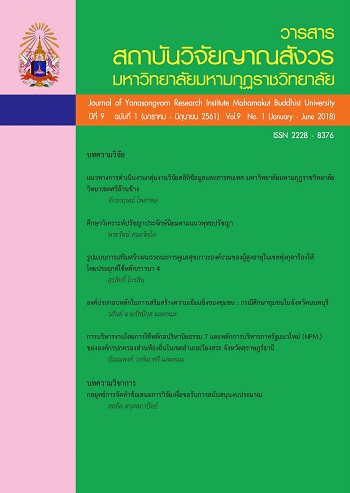องค์ประกอบหลักในการเสริมสร้างความเข้มแข็งของชุมชน : กรณีศึกษาชุมชนในจังหวัดนนทบุรี
Main Article Content
บทคัดย่อ
งานวิจัยเรื่องนี้มีวัตถุประสงค์เพื่อศึกษาองค์ประกอบหลักในการเสริมสร้างความเข้มแข็งของชุมชน : กรณีศึกษาชุมชนในจังหวัดนนทบุรี เป็นการวิจัยเชิงปริมาณ ประชากรคือผู้ที่อาศัยอยู่ในจังหวัดนนทบุรี จำนวน 1,193,711 คน การกำหนดกลุ่มตัวอย่างใช้ 20 เท่าของตัวแปร ได้กลุ่มตัวอย่างทั้งสิ้น 500 ตัวอย่าง และสุ่มตัวอย่างโดยวิธีสุ่มแบบบังเอิญ ตามสัดส่วนที่กำหนดไว้ในแต่ละตำบล ในจังหวัดนนทบุรี เครื่องมือที่ใช้เป็นแบบสอบถาม และความเชื่อมั่นของเครื่องมือทั้งฉบับ 0.932 แล้ววิเคราะห์ข้อมูลโดยใช้การวิเคราะห์องค์ประกอบเชิงสำรวจ ผลการวิจัยพบว่า องค์ประกอบหลักในการเสริมสร้างความเข้มแข็งของชุมชน: กรณีศึกษาชุมชนในจังหวัดนนทบุรี ประกอบไปด้วย 6 องค์ประกอบได้แก่ องค์ประกอบที่ 1. ทุนทางสังคม องค์ประกอบที่ 2. ผู้นำชุมชน องค์ประกอบที่ 3. การมีส่วนร่วมของชุมชน องค์ประกอบที่ 4. ความสามารถในการพึ่งตนเอง องค์ประกอบที่ 5. มนุษยสัมพันธ์ของคนในชุมชน และองค์ประกอบที่ 6. ศักยภาพของคนในชุมชน
Article Details
เอกสารอ้างอิง
ชลกร ศิรวรรธนะ. (2554). บทบาทของสมาชิกสภากรุงเทพมหานคร เขตดินแดง ในการเสริมสร้างความเข้มแข็งของชุมชนแฟลตดินแดง. วิทยานิพนธ์รัฐศาสตรมหาบัณฑิต, มหาวิทยาลัยเชียงใหม่.
นิธิ เอี่ยวศรีวงศ์. (2541). ชุมชนเข้มแข็ง ทุนทางสังคมไทย. กรุงเทพมหานคร: สำนักงานกองทุนเพื่อสังคม.
ประเวศ วะสี. (2541). ประชาคมตำบล: ยุทธศาสตร์เพื่อการพัฒนาเศรษฐกิจพอเพียง ศีลธรรม และสุขภาพ. กรุงเทพมหานคร: มติชน.
ไพบูลย์ วัฒนศิริธรรม. (2541). ประชาคมตำบล. กรุงเทพมหานคร: สถาบันชุมชนท้องถิ่นพัฒนา.
มนตรี ศิริจันทร์ชื่น. (2545). ภาวะผู้นำในการพัฒนาชุมชน. กรุงเทพมหานคร: สำนักพิมพ์มหาวิทยาลัยราชภัฏเชียงใหม่.
ศศิภา ปัญญาวัฒนาสกุล, ชมภูนุช หุ่นนาค, พลศักดิ์ จิรไกรศิริ, สมเจตน์ พันธูโฆษิต, (2559). การมีส่วนร่วมในการจัดการความรู้ชุมชน: กรณีเขื่อนไผ่ชะลอคลื่นในพื้นที่ชายฝั่งทะเลจังหวัดสมุทรสาคร. Veridian E-Journal ฉบับภาษาไทย สาขามนุษยศาสตร์ สังคมศาสตร์ และศิลปะ, 9 (3), 29-47.
สมบูรณ์ สุริยวงศ์. (2550). การวิเคราะห์องค์ประกอบ. กรุงเทพมหานคร: สำนักพิมพ์มหาวิทยาลัยรามคำแหง.
สุวิมล ติรกานันท์ (2555). การวิเคราะห์ตัวแปรพหุในงานวิจัยทางสังคมศาสตร์. (พิมพ์ครั้งที่ 2). กรุงเทพมหานคร: จุฬาลงกรณ์มหาวิทยาลัย.
สำนักงานคณะกรรมการพัฒนาการเศรษฐกิจและสังคมแห่งชาติ. (2555). แผนพัฒนาเศรษฐกิจและสังคมแห่งชาติฉบับที่ 11 (พ.ศ. 2555-2559). กรุงเทพมหานคร: สํานักนายกรัฐมนตรี.
สมบูรณ์ ธรรมลังกา. (2556). รูปแบบการเสริมสร้างความเข้มแข็งของชุมชนโดยใช้ภูมิปัญญาท้องถิ่นเป็นฐานในจังหวัดเชียงราย. วารสารศึกษาศาสตร์ มหาวิทยาลัยนเรศวร, 15(2), 58-67.
สำนักงานจังหวัดนนทบุรี. (2560). บรรยายสรุปขัอมูลจังหวัดนนทบุรี. นนทบุรี: กลุ่มงานยุทธศาสตร์และข้อมูลเพื่อการพัฒนาจังหวัด. สืบค้น 15 มีนาคม, 2560, จาก http://nonthaburi.go.th.
อภิชัย พันธเสน. (2547). พุทธเศรษฐศาสตร์ : วิวัฒนาการ ทฤษฎี และการประยุกต์กับเศรษฐศาสตร์สาขาต่าง ๆ (พิมพ์ครั้งที่ 3). กรุงเทพฯ: อมรินทร์พริ้นติ้ง แอนด์ พับลิชชิ่ง.
เอกศักดิ์ เฮงสุโข, (2557) ศักยภาพของชุมชนในการสร้างเสริมสุขภาพด้วยการออกกำลังกายของผู้สูงอายุ. วารสารวิจัย มสด สาขามนุษยศาสตร์และสังคมศาสตร์,10,129-142.
Joseph F. Hair, Jr. et al. (2010). Multivariate Data Analysis.Boston.


